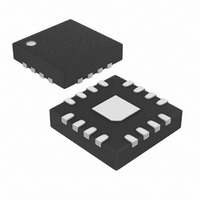MAX9723AETE+T Maxim Integrated Products, MAX9723AETE+T Datasheet - Page 11

MAX9723AETE+T
Manufacturer Part Number
MAX9723AETE+T
Description
IC AMP AUDIO .06W STER AB 16TQFN
Manufacturer
Maxim Integrated Products
Series
DirectDrive™r
Type
Class ABr
Datasheet
1.MAX9723DETE.pdf
(25 pages)
Specifications of MAX9723AETE+T
Output Type
Headphones, 2-Channel (Stereo)
Max Output Power X Channels @ Load
60mW x 2 @ 16 Ohm
Voltage - Supply
1.8 V ~ 3.6 V
Features
Bass Boost, Depop, I²C, Mute, Short-Circuit and Thermal Protection, Shutdown, Volume Control
Mounting Type
Surface Mount
Package / Case
16-TQFN Exposed Pad
Lead Free Status / RoHS Status
Lead free / RoHS Compliant
The output-coupling capacitor is a major contributor of
audible clicks and pops in conventional single-supply
headphone amplifiers. The amplifier charges the cou-
pling capacitor to its output bias voltage at startup.
During shutdown the capacitor is discharged. This
charging and discharging results in a DC shift across
the capacitor, which appears as an audible transient at
the speaker. Since the MAX9723 headphone amplifier
does not require output-coupling capacitors, no audi-
ble transients occur.
Additionally, the MAX9723 features extensive click-and-
pop suppression that eliminates any audible transient
sources internal to the device. The Power-Up/Power-
Down Waveform in the Typical Operating Characteristics
shows that there are minimal transients at the output upon
startup or shutdown.
In most applications, the preamplifier driving the
MAX9723 has a DC bias of typically half the supply.
The input-coupling capacitor is charged to the pream-
plifier’s bias voltage through the MAX9723’s input
impedance (R
shift across the capacitor creates an audible click/pop.
To avoid clicks/pops caused by the input filter, delay
the rise of SHDN by at least 4 time constants, 4 x R
C
Typical headphones do not have a flat-frequency
response. The small physical size of the diaphragm
does not allow the headphone speaker to efficiently
reproduce low frequencies. This physical limitation
results in attenuated bass response. The MAX9723
includes a bass boost feature that compensates for the
headphone’s poor bass response by increasing the
amplifier gain at low frequencies.
The DirectDrive output of the MAX9723 has more head-
room than typical single-supply headphone amplifiers.
This additional headroom allows boosting the bass fre-
quencies without the output-signal clipping.
Program the BassMax gain and cutoff frequency with
external components connected between OUT_ and
BB_ (see the Functional Diagram/Typical Operating
Circuit). Use the I
command register to enable/disable the BassMax circuit.
BB_ is connected to the noninverting input of the output
amplifier when BassMax is enabled. BB_ is pulled to
SGND when BassMax is disabled. The typical application
of the BassMax circuit involves feeding a lowpass version
of the output signal back to the amplifier. This is realized
IN
, relative to the start of the preamplifier.
IN
) during startup. The resulting voltage
2
C-compatible interface to program the
______________________________________________________________________________________
Stereo DirectDrive Headphone Amplifier
with BassMax, Volume Control, and I
Click-and-Pop Suppression
BassMax (Bass Boost)
IN
x
using positive feedback from OUT_ to BB_. Figure 2
shows the connections needed to implement BassMax.
The MAX9723A and MAX9723B have selectable
maximum gains of -5dB or 0dB (see Table 5) while
the MAX9723C and MAX9723D have selectable maxi-
mum gains of +1dB or +6dB (see Table 6). Bit 5 in the
command register selects between the two maximum
gain settings.
The MAX9723 includes a 32-level volume control that
adjusts the gain of the output amplifiers according to
the code contained in the command register. Volume is
programmed through the command register bits [4:0].
Tables 7–10 show all of the available gain settings for
the MAX9723A–MAX9723D. The mute attenuation is
typically better than 100dB when driving a 32Ω load.
The MAX9723 features an I
2-wire serial interface consisting of a serial data line
(SDA) and a serial clock line (SCL). SDA and SCL facili-
tate communication between the MAX9723 and the
master at clock rates up to 400kHz. Figure 3 shows the
2-wire interface timing diagram. The MAX9723 is a
receive-only slave device relying on the master to gen-
erate the SCL signal. The MAX9723 cannot write to the
SDA bus except to acknowledge the receipt of data
Figure 2. BassMax External Connections
AUDIO
INPUT
MAX9723
BassMax
R
ENABLE
R
Maximum Gain Control
2
OUT_
C/SMBus-compatible,
BB_
Serial Interface
Volume Control
R1
R2
2
C3
C
11












